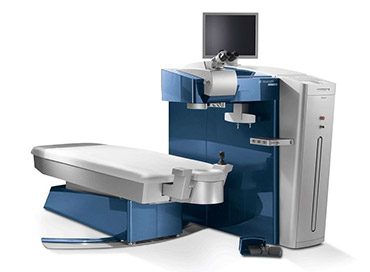PRK Surgery
Photorephractive keratectomy (PRK) is a type of laser vision correction surgery in which the surface layer of the cornea (known as the epithelium) is removed in order to re-shape the cornea with a laser.
PRK can treat a variety of common refractive errors, including:
- Myopia (nearsightedness)
- Hyperopia (farsightedness)
- Astigmatism (blurry vision at all distances)
Like LASIK, the procedure itself only last for a few minutes per eye. While some patients report a slight discomfort during and after the procedure, most people are surprised by how quick and relatively painless the procedure is overall.
Who’s A Good Candidate For PRK?
PRK is often recommended for patients whose corneas are thinner-than-average and thus do not safely allow for the creation of the corneal flap required in traditional LASIK surgery. It may also be recommended to people who have softer corneas, which carry a greater risk of bending out of shape and are also not suitable for the creation of a corneal flap.
Additionally, some individuals with vocational or sports-related limitations are recommended PRK, as the creation of a corneal flap would carry greater risk for them since they are more likely to experience physical trauma to the eye.
What’s The Difference Between PRK and LASIK?
PRK is often referred to as “LASIK without a flap” since it doesn’t require the creation of a corneal incision. Rather, the surgeon simply removes the epithelium by scrubbing it away, which then allows them to use the laser to reshape the cornea in the same way as LASIK.
The epithelium takes approximately three to five days to grow back. During this time, the patient must wear special contact lenses in order to protect their eye. As such, there is a slightly longer healing period with PRK versus LASIK as well as more frequent post-operative appointments.
Please note that both LASIK and PRK offer the same quality of visual outcomes and are equally safe.
The Alcon WaveLight Allegretto EX500
At Laservue, our surgeons use the Alcon WaveLight Allegretto EX500 to perform PRK surgeries in order to offer the best visual results.

The development of the Alcon WaveLight Allegretto EX500 was a ground-breaking moment in laser vision correction. It was the first excimer laser to be used in wavefront-guided treatments, which can measure aspects of a patient’s refractive error that cannot be detected during traditional scans, thus allowing for better visual results.
The laser comes with a variety of advanced features, including:
- Quick Speed: the laser delivers 200 individual pulses per second, thus reducing the risk of any rare, adverse outcomes.
- Beam Size: with a diameter of only 0.68mm, the small beam features a Gaussian profile for smoother ablation.
- A 500Hz Eye Tracker: this enables the laser to track the eye’s movements with only 2 milliseconds of latency, which allows for an increased speed of over 1.4 seconds per diopter
- Optical Zones: the laser features a combination of optical zones ranging from 1.5 mm to 8 mm, which reduces night vision problems in patients post-surgery.
The Alcon WaveLight Allegretto makes it possible to treat a larger area of the cornea compared to other types of lasers. Coupled with the aforementioned features, the laser allows the surgeon to create a more natural cornea shape, which results in a higher quality of vision. Specifically, the Alcon WaveLight Allegretto is known to reduce or eliminate glare and halos while driving at night and offers better visual results in low-light conditions.
Are you ready to start living free of glasses and contacts?
Call us or book a free, no-obligation consultation online today: